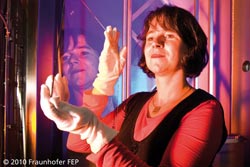Fraunhofer FEP presents novel, indium-free, transparent conducting Electrodes in Chicago

Glass plate with a transparent conducting layer based on titanium dioxide. The electrode material of the future? © Fraunhofer FEP<br>
At the international trade fair SVC (Society of Vacuum Coaters) on 19-20 April 2011 the Fraunhofer FEP will present for the first time a large-scale transparent conducting oxide (TCO) layer based on titanium dioxide, containing small amounts of niobium. The layer has similar conductivity and transparency to other indium-free materials, but has greater resistance to chemicals and to temperatures up to 550°C.
Transparent conducting layers are important components of flat displays and solar cells. Their function is to conduct electricity with low loss, for example the electricity generated from sunlight in a solar cell must be transferred to the electrical circuit. The conducting coating must not, however, shade the solar cell. The primary requirements on the coating are therefore high optical transparency and electrical conductivity.
The Fraunhofer FEP is able to apply such layers to glass on an industrial scale. Although the Fraunhofer FEP researchers have not yet achieved the excellent properties of conventional indium-tin-oxide coatings (ITO) with their layers, their materials are indium-free. Dr. Torsten Kopte, leader of the »Plasma I« group at the Fraunhofer FEP explains the importance of this: »Indium is becoming ever scarcer, and is mainly mined in China. For European companies it is important not to be dependent on Chinese raw materials. We are developing indium-free TCO materials in order to stay competitive and independent in electronics industry.« Unlike indium, titanium dioxide, which is also used in opaque white paint and toothpaste,
is a readily available raw material. Titanium dioxide, with its high refractive index, is a tried and tested material for optical applications and is used for coating heat-insulating glass and for anti-reflective coatings for spectacles.
Manuela Junghähnel is developing conducting layers at the Fraunhofer FEP and is evaluating the research results: »For applications such as light outcoupling for blue LEDs, our titanium dioxide layer technology is already very suitable due to its refractive index. The high refractive index of the layers may also be advantageous in solar cells for improved light trapping. We can however customize the layers, meaning we have a certain freedom to tailor properties such as the optical transparency, refractive index, and electrical conductivity to the specific application.«
For further information please visit us at the SVC 2011 trade fair in Chicago at stand no. 1334.
There you will be able to measure the resistance of the layers yourself!
Scientific contact:
Dr. Marita Mehlstäubl
Fraunhofer Institute for Electron Beam and Plasma Technology FEP
Phone +49 351 2586-214
marita.mehlstaeubl@fep.fraunhofer.de
Press contact:
Annett Arnold
Fraunhofer Institute for Electron Beam and Plasma Technology FEP
Phone +49 351 2586-452
annett.arnold@fep.fraunhofer.de
Media Contact
More Information:
http://www.fep.fraunhofer.de/enu/All latest news from the category: Trade Fair News
Newest articles

Largest magnetic anisotropy of a molecule measured at BESSY II
At the Berlin synchrotron radiation source BESSY II, the largest magnetic anisotropy of a single molecule ever measured experimentally has been determined. The larger this anisotropy is, the better a…

Breaking boundaries: Researchers isolate quantum coherence in classical light systems
LSU quantum researchers uncover hidden quantum behaviors within classical light, which could make quantum technologies robust. Understanding the boundary between classical and quantum physics has long been a central question…

MRI-first strategy for prostate cancer detection proves to be safe
Active monitoring is a sufficiently safe option when prostate MRI findings are negative. There are several strategies for the early detection of prostate cancer. The first step is often a…



